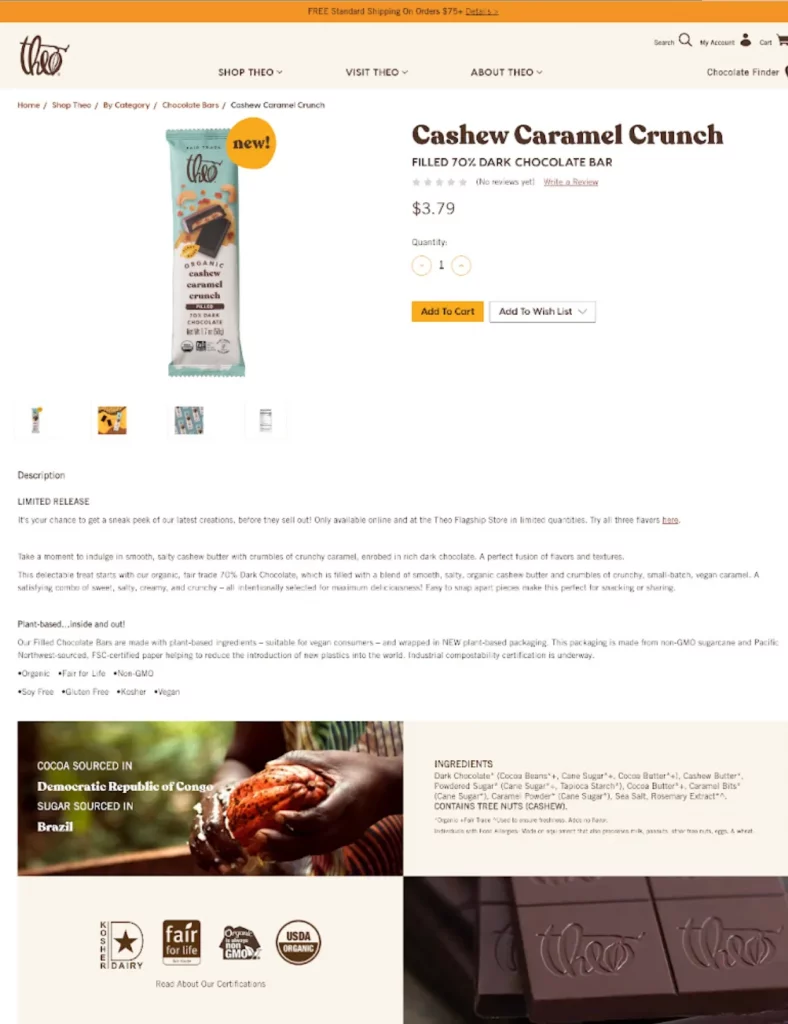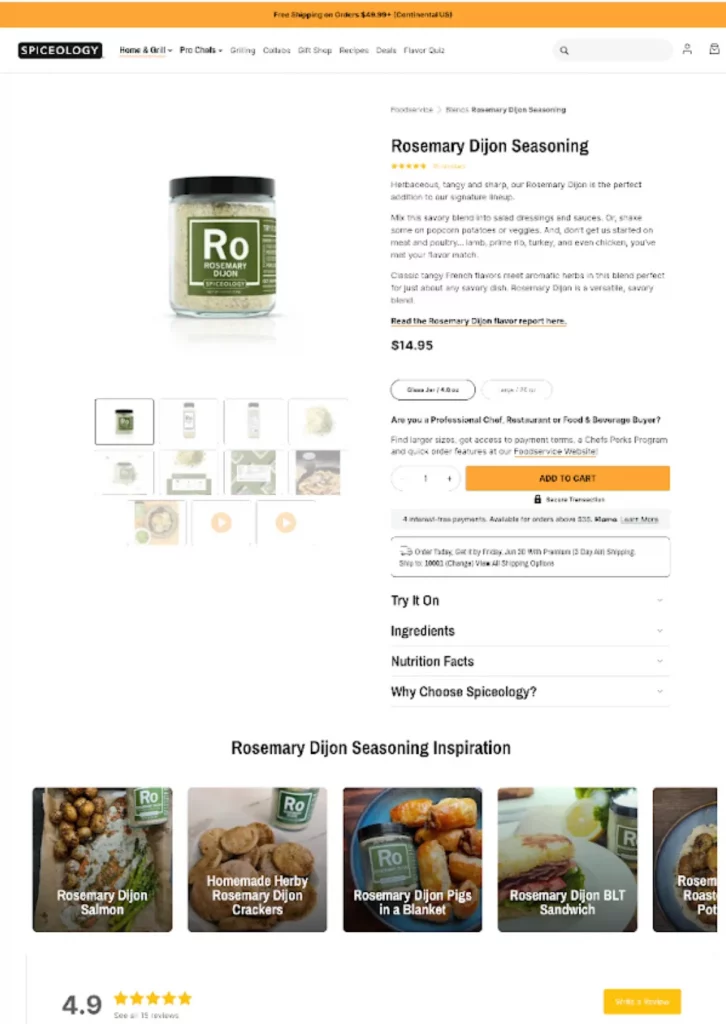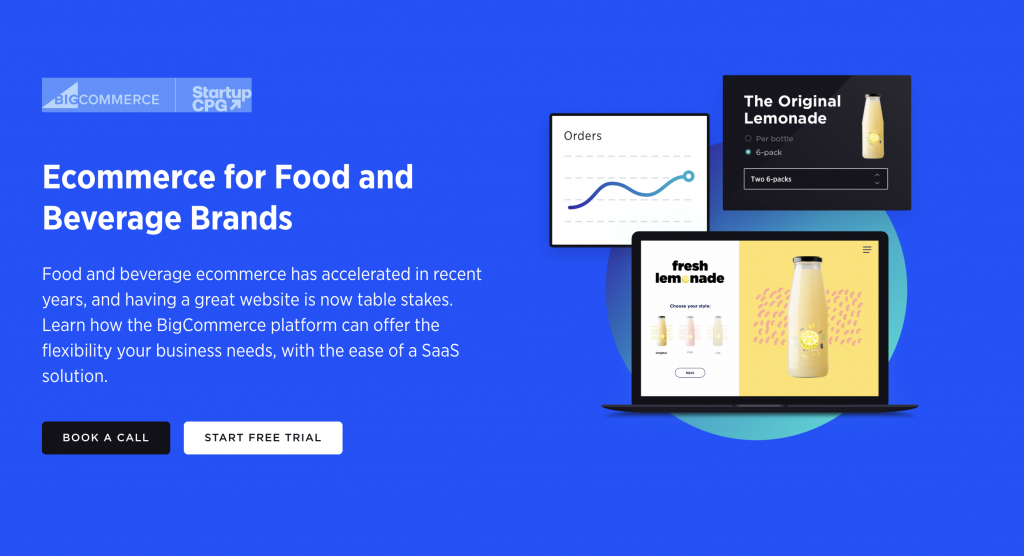How to
Increase Conversions Online with an Optimized Product Page
High-quality product content can play a critical role in online purchase decisions. A product page contains essential information about a product a customer is interested in, including a description, item specifications, images, pricing, FAQs and more.
The best product pages can help overcome the disconnect that naturally occurs in online shopping: customers can’t see, touch or try the product before purchase. Consequently, the page must provide all the relevant information and alleviate any misgivings the customer has about purchasing from an ecommerce store.
A product page serves several distinct purposes, including:
- Provide detailed product information: The page should include essential details about the product, such as its features, benefits, dimensions and specifications.
- Build trust: Well-crafted product detail pages anticipate any questions or concerns customers may have, minimizing doubt regarding their purchase.
- Encourage conversions: Educating the customer, building trust and highlighting product features and benefits increase the chances of a sale.
A simple layout, clear call-to-action, and engaging copy can help drive conversions. Let’s take a deeper dive into how your business can create compelling product pages that help the user experience.
Essential Ecommerce Product Page Elements
Effective ecommerce product pages have a few things in common: a clean layout, keyword optimization and thorough product descriptions.
Customize the user journey.
A well-designed ecommerce product page personalizes the shopping experience by offering product recommendations, displaying the most relevant information according to the user’s search intent and optimizing the layout for the user’s device.
For example, if a customer is browsing for a particular product feature (e.g. “self-cleaning cat litter box”), the page can highlight that feature and provide in-depth information about it. This can improve the customer experience and increase the likelihood of a sale.
Detailed product information.
Great product pages contain comprehensive information about the item. The page template should be structured in an easy-to-read format, with relevant information presented in a logical order.
Here are the key elements of an effective product page:
- Product description: Include all essential details about the product, including its features, benefits, uses and specifications. This includes measurements and dimensions, materials and care instructions.
- Product images and videos: Include high-resolution product photos and videos that showcase the product from multiple angles and depict how it looks in real life. Enable customers to zoom in and out of images.
- Product configurator (if applicable): A product configurator enables customers to interact with a 3D rendering of a product and apply customer features such as colors, materials or upgrades. This functionality is ideal for customizable items.
- Pricing and availability: Include applicable taxes, shipping and other applicable fees, plus available discounts or promotions.
- Customer reviews and ratings: Positive customer testimonials provide social proof and boost credibility, helping customers make an informed purchase decision.
- Product comparison: A comparison table shows how the product compares to similar goods in terms of features, benefits and price.
- Warranty and return policy: Explain the warranty and return policy to help customers feel confident about their purchase and reduce the likelihood of returns or disputes.
- Frequently Asked Questions (FAQs): Provide a list of FAQs to save customers the trouble of contacting customer support.
High-resolution visuals.
Crisp product photography can increase conversions. Research indicates that up to 75% of shoppers rely on product images to make buying decisions. High-resolution images show product details and features easily, enabling customers to assess product quality. Customers should be able to see the quality of the stitching on a clothing item or the luster of a gem.
Here are the types of product images you should include:
- Product-only images: Show the product against a neutral background free from distractions.
- Lifestyle images: Show the product being used in real-life scenarios. These help customers visualize how the product would look and feel in their own lives and increase its perceived value.
- 360-degree images: Let customers view the product from multiple angles by rotating the image.
- Infographic images: Use graphics and text to highlight specific product features and benefits. Infographic images can be used to communicate complex product information in an easy-to-understand format.
Pricing incentives.
Pricing incentives reduce barriers to purchase. Incentives can be used to reward loyalty or induce a first-time purchase. Ecommerce businesses typically use a combination of incentives depending on the customer’s purchase history, average order value and recent activity.
Here are a few examples of incentives that work:
- Discounts: These can be percentage-based (e.g. 10% off the purchase price) or a fixed amount (e.g. $20 off).
- Limited-time offer: Offering a special price for a limited time creates a sense of urgency.
- Free shipping: Free shipping is an ideal incentive if the shipping cost is high or the product is heavy or bulky.
- Buy-One-Get-One (BOGO): This offer is ideal for items purchased repeatedly or in bulk (e.g. dish detergent) by offering a free product with purchase or a discount on a second product. Bundle offers are also effective for this product type.
- Loyalty discounts: Encourage customers to join your loyalty program and make repeat purchases.
- Price match guarantee: Offering to match your competitor’s prices encourages customers to purchase from your site instead.
SEO optimized.
Product pages must rank in search results so that customers see your product offering when they search for corresponding keywords.
Use a keyword research tool to identify the keywords (“laptop”) and long-tail phrases (“best gaming laptops under $500”) your audience uses to search for your product. Insert those keywords in the page’s URL, title tags, meta description, product name and product description.
Here are some other page elements you can optimize:
- Page headings: Use H1 tags for the page title or main heading and H2 tags for subheadings. Frontload keywords to enable search engines to crawl the content.
- Product images: Use relevant keywords in image filenames and alt tags.
- Customer reviews: Search engines view user-generated content as valuable, boosting page ranking.
- Schema markup: This is the structured data search engines use to characterize page content. Provide product metadata such as product title, description, price, category, and SKU.
- Page load speed: Ensure the page loads quickly, as this is a ranking factor for search engines and directly affects conversions. A site that loads in one second has a conversion rate three-times higher than one that loads in five seconds.
Some ecommerce platforms, like BigCommerce, help you optimize your product pages as you create them. Merchants can edit meta descriptions, alt text, and more right from the backend, so SEO doesn’t have to come as an afterthought.
Premium shipping alternatives.
Offer options beyond standard shipping for customers who require fast delivery (e.g. those buying last-minute gifts for the holidays) or those purchasing from abroad.
Here are a few premium shipping alternatives to consider:
- Expedited or same-day delivery: Same-day delivery is ideal for fast-moving consumer goods such as groceries and other perishables.
- Weekend delivery: Some deliveries require sign-off from the recipient. Offering weekend delivery is a good choice for customers who need items delivered on a specific day.
- International shipping: Shipping overseas is a good choice for customers unable to find the products they need locally.
- Premium packaging: This option may include gift wrapping, custom packaging, or other special touches. This is especially important if you ship fragile items like wine bottles or artwork.
Live chat support.
No matter how thorough your product page is, you can’t anticipate every conceivable customer question. Live chat support, including a homepage pop-up, enables customers to receive immediate answers to their queries, boosting satisfaction and trust.
If a potential buyer has to email customer support and await a response, this creates a communication barrier and increases the likelihood they’ll purchase from a competitor in the meantime. An expedient resolution increases the chances of a sale.
An FAQ section.
Anticipate what questions or concerns customers might have before finalizing a purchase. How common is this product? Does its usage require explanation or is it obvious? What product features might customers be unfamiliar with?
Here are some frequently asked questions (FAQs) to include:
- What are the product specifications? Include information such as weight, dimensions and material.
- How do I use the product? Provide usage instructions, including any special care or maintenance instructions.
- What is the product made of?
- Is the product safe for children?
- Is the product available in different colors or sizes? If the product is available in different colors, sizes or variants, provide information on the available options.
Suggest similar products.
Suggest similar items to the product the customer is currently viewing to help them zero in on what they’re looking for and discover items outside of their initial search. You can also cross-sell items in a product category that’s relevant to the customer’s interests or upsell a premium version of the product.
Best Ecommerce Product Page Examples
The best product page examples make it easy for customers to understand what they’re buying. Here are some product page design examples that lead to a great online shopping experience.
Theo Chocolate

Theo Chocolate follows all the best practices when it comes to product page optimization. The photography is on point, the product description is detailed and thorough, and shoppers can browse related products below. This is a great example of how less can certainly be more when it comes to product pages and descriptions.
Spiceology

Spiceology’s product pages do a great job showing off their unique seasonings. Our favorite piece of this page is the inspiration section. Not only can shoppers learn about the seasoning in the description, they can also get ideas for how to use the seasoning on their own with tasty recipes and tips.
Lammes Candies

Lammes Candies’ product page looks as good as their pralines do. It tells you everything you need to know about the product, from portion size to shipping and nutrition information, and it even allows you to select gift options. This description is thorough, and all the information a shopper could want is clearly presented.
The Final Word
Product pages are a critical part of any ecommerce website and online store. They provide essential information about your products, helping customers understand if it meets their needs. Providing clear and accurate information builds trust. Additionally, your product page is often the first interaction a potential customer has with your brand. It’s important to make a great first impression with a page that is visually appealing and easy to navigate.
At BigCommerce, the sky’s the limit when it comes to your product page design. Want to learn more about how BigCommerce can help you create the perfect online store for your food or beverage brand? Learn more about how you can grow your online sales with BigCommerce here.




All Comments